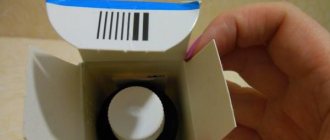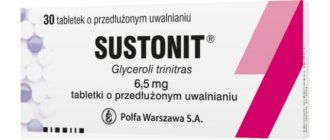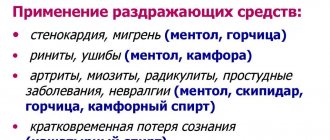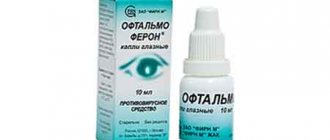Indications for use
Aeron's ability to relax the smooth muscles of the gastrointestinal tract causes the reduction and prevention of vomiting and nausea after its use.
Due to these properties, Aeron is prescribed in the following cases:
- Prevention and treatment of air and sea sickness;
- Preventing and eliminating symptoms of Meniere's disease;
- Plastic surgery and surgery on the upper respiratory tract to reduce mucus and salivation (in progress).
The use of Aeron is allowed for vomiting and nausea of pregnant women to eliminate or alleviate toxicosis.
special instructions
In case of hypersensitivity to the components of Aeron or its use in high doses, poisoning is possible, accompanied by the following symptoms:
- Cardiopalmus;
- Increased body temperature;
- Severe dry mouth;
- Pain in the eyes;
- Vomit;
- Decreased vision;
- Euphoria;
- Weak reaction of the pupil to light;
- Confusion;
- Photophobia;
- Hallucinations;
- Confusion;
- Coma;
- Death.
If symptoms of poisoning occur, you should immediately call an ambulance. The patient's stomach is washed, an intravenous infusion of anticholinergics (proserin) is given, and symptomatic therapy is given.
Directions for use and dosage
Prevention of sea and air sickness with Aeron tablets occurs according to the following scheme: half an hour or an hour before departure you need to take 1-2 pieces, after 6 hours, if necessary, 1 more tablet. If preventive measures have not been taken, treatment should begin after the first sensations of illness, such as headache, dizziness, nausea - you should take 1 or 2 Aeron tablets, then the drug is taken 2 times a day, 1 tablet.
The maximum possible single dose of the drug for an adult is 2 tablets, while the daily dose should not exceed 4 tablets.
For Meniere's disease, the regimen for using the drug is as follows: 2-3 times a day, 1 tablet.
To reduce mucus and salivation, 2 tablets are taken half an hour before surgery, and for the next two days - 1 tablet 2 times a day.
Pharmacological action of Aeron
The action of Aeron tablets is associated with the pharmacological properties of its active ingredients - hyoscyamine and scopolamine.
According to the instructions, Aeron is an M-anticholinergic drug, and its action is mainly aimed at reducing the stimulating effect of the chemical acetylcholine, due to which neuromuscular transmission occurs.
The use of the drug helps to reduce the secretion of the lacrimal, bronchial, sweat, salivary and gastric glands, as well as the pancreas. Thus, the effect of the drug is aimed at reducing the tone of the muscles of the bile ducts and gallbladder, the gastrointestinal tract. In addition, the drug helps improve the conduction of impulses in the heart through the atrioventricular node.
Aeron tablets relax the smooth muscles of the gastrointestinal tract, resulting in vomiting and nausea being reduced or prevented. Aeron also dilates the pupils, impedes the outflow of intraocular fluid, increases intracranial pressure and causes paralysis of accommodation (impaired vision at close range). Produces a sedative effect.
Anti-sickness pills for children
Young children are too sensitive to motion sickness. After all, their vestibular apparatus has not yet formed. There are anti-motion sickness medications for children that it is advisable to take before air travel. True, they are not intended specifically for young travelers. It is necessary to take the correct dose based on the age of the individual child.
Types of funds:
- Dramamine. It is allowed to give to a child after one year. The medication is taken 30 minutes before the flight. Children under 6 years old are given ¼, up to 12 years old - ½, over 12 years old - one whole tablet.
- Aminalon. It is recommended to give to children after one year. Before departure, give 0.25 g (1 piece). Relieves symptoms of nausea.
- Vertichogel. It is allowed to use after a year (in drops) or from 3 years (in capsules). Before the trip, drop 3 drops into 5 ml of water or give one capsule under the tongue. After 4 hours, you can repeat the dose.
- Vitaton. These are lollipops for motion sickness. They taste like ginger and mint. Taken directly in flight, but no more than 4 lozenges per day.
Causes of motion sickness on an airplane
Kinetosis, or motion sickness syndrome, is a pathological reaction of the body to an unusual movement. Air passengers sometimes get motion sickness while flying on an airplane. The reason for this unpleasant condition is irritation of the vestibular organ, as well as the visual analyzer and various receptors. Then an imbalance occurs between the information entering the central nervous system. A person has a motionless and constant picture before his eyes, but in reality his body is subject to vibrations. The brain incorrectly processes the received signals, which causes a person’s well-being to deteriorate.
Suspicious and excitable people are often susceptible to motion sickness. Preceding factors: strong smell of tobacco, fear, stuffiness in the cabin, overwork, pregnancy. Young children are most susceptible to motion sickness. After all, their vestibular apparatus fully matures only by 12–16 years. In order to get rid of unpleasant symptoms, you need to take anti-motion sickness medications.
Not all passengers get motion sickness on an airplane, because the appearance of painful symptoms depends only on individual predisposition and on the insufficient training of the vestibular apparatus of a particular person.
How to prepare for a flight?
If a passenger often feels sick on an airplane, he must first prepare for the flight. Before the trip you need to get enough sleep and rest. You shouldn't lie in bed for too long. Excessive energy will not allow you to relax during the flight. You should not overeat before going to the airport. However, it is also not recommended to fly on an empty stomach. This will only make the nausea worse. It is better to eat a vegetable dish and yogurt.
You should not drink a lot of fluids before the trip. The consumption of soda and milk is prohibited. You can drink kefir or juice. Before the trip, it is advisable not to drink alcohol or smoke. It is better to ask for a plane ticket in the bow or central part.
Symptoms of motion sickness
There are the following signs that characterize motion sickness on an airplane:
- from the nervous system: lethargy, headache, drowsiness, fear, depression;
- gastrointestinal problems: nausea, vomiting, metallic taste in the mouth, lack of appetite;
- cardiovascular disorders: increased blood pressure, slight arrhythmia, increased heart rate, and as the condition worsens, the pulse slows down and the pressure drops;
- autonomic disorders: pallor, severe sweating.
How to prevent it?
If a passenger often gets motion sickness during a flight, it is better for him to choose night flights. They are easier to carry. You can sleep during the flight. On an airplane you need to turn your head less. During turbulence, keep your head straight. When flying, you don’t need to look out the windows; it’s better to close your eyes. You can listen to quiet and calm music.
It is recommended to suck hard candies during takeoff and landing. Sucking reduces the symptoms of motion sickness. It is advisable to breathe deeply and yawn. You can get rid of attacks of nausea by moving your legs, tapping your feet, heels and toes on the floor. Such movements resemble walking and balance signals coming from the vision and vestibular system. It is recommended to take anti-sickness medications 30 minutes or 1 hour before the flight.
Aerosol for air disinfection AERON 250ml
DESCRIPTION
AERON disinfectant is a ready-made, odorless product for disinfecting indoor air.
COMPOUND
Contains polyhexamethylene guanidine hydrochloride (0.16%) and didecyldimethylammonium chloride (0.03%) as active ingredients, as well as a corrosion inhibitor, stabilizer, propellant and other functional additives.
PROPERTIES
The product has antimicrobial activity against gram-negative and gram-positive (including Mycobacterium tuberculosis) microorganisms, viruses (against all known human pathogenic viruses, including enteral and parenteral hepatitis viruses (including hepatitis A, B and C), HIV , polio, adenoviruses, SARS viruses, bird flu H5Nl, swine flu, human influenza, herpes, etc.), fungi of the genus Candida, Trichophyton and mold fungi, causative agents of nosocomial infections.
In terms of the degree of impact on the body, according to GOST 12.1.007-76, AERON belongs to class 4 of low-hazard substances when administered into the stomach and applied to the skin, does not have a local irritating effect on the skin, does not cause irritation of the mucous membranes of the eyes, and does not have a sensitizing effect. In case of inhalation exposure, if the consumption rate is exceeded, it may cause irritation of the upper respiratory tract.
The maximum permissible concentration in the air of the working area of polyhexamethylene guanidine hydrochloride didecyldimethylammonium chloride is 1 mg/r.
PURPOSE
The product is intended for disinfecting the air of premises in health care facilities (wards, medical and treatment rooms, emergency rooms, infectious disease hospital boxes, children's playrooms, vestibules, dirty linen sorting rooms, smoking rooms, toilets), etc. for bacterial and viral infections, tuberculosis and infections of fungal etiology, as well as for preventive disinfection in health care facilities of any profile, in communal facilities and service sector facilities (offices, massage and beauty salons, hairdressers, baths, saunas, laundries, sports clubs, offices and reception areas of administrative institutions); in preschool, school and other educational institutions; population in everyday life; disinfection of small surfaces in rooms, hard and upholstered furniture, floor coverings and upholstery fabrics, furnishings, surfaces of apparatus, appliances, sanitary equipment, rubber and polypropylene mats, cleaning equipment and materials, toys, sports equipment, care items patients, personal hygiene items, furnishings (including blinds, bactericidal lamps), hard furniture (operating rooms, maternity tables, gynecological chairs, etc.); medical devices and equipment; optical instruments, equipment in clinical, microbiological and other laboratories; sensors for medicine, including ultrasound machines, tips, mirrors, thermometers and other small products; preventive disinfection of ventilation and air conditioning systems; combating mold.
MODE OF APPLICATION
To disinfect the air, the product is used by spraying in a room at the following rate: for bacterial infection - 1 sec/m3, disinfection holding time is 30 minutes; for viral infection - 2 sec/m3, disinfection holding time is 20 minutes; for fungal infections and tuberculosis - 2 sec/m3, disinfection holding time is 30 minutes.
In 1 second, an azrozole cylinder is capable of spraying at least 1 ml of disinfectant. The product should be sprayed by directing the stream upward, using short presses, moving around the room.
At the end of the disinfection holding time, the room should be ventilated for 15 minutes. One cylinder of the product with a volume of 1000 ml is sufficient to treat air with a volume of at least 750 m3, one cylinder of the product with a volume of 50 ml is sufficient to treat air with a volume of at least 37.5 m3.
Disinfection of small surfaces in rooms, hard and upholstered furniture, floor coverings and upholstery fabrics, furnishings, surfaces of apparatus, appliances, sanitary equipment, linen, dishes (including disposable and laboratory dishes), dishwashing utensils, rubber and polypropylene mats, cleaning equipment and materials, toys, sports equipment, patient care items, personal hygiene items in healthcare facilities (including clinical, diagnostic and bacteriological laboratories, neonatology, maternity hospitals, neonatal wards, etc.), in children's institutions, in infectious diseases foci during current, final and preventive disinfection are carried out based on the following calculation: for bacterial infection - 10 sec/m2, disinfection holding time is 30 minutes; for viral infection - 20 sec/m2, disinfection holding time is 20 minutes; for fungal infections and tuberculosis - 20 sec/m2, disinfection holding time is 30 minutes.
To combat mold, indoor surfaces are first cleaned of mold, then treated with a product based on the calculation of 15 sec/m2.
SHELF LIFE AND STORAGE
The shelf life of the product in the manufacturer's packaging at temperatures from minus 20° C to plus 40° C is 3 years.
PACKAGE
The product is available in azrozole packaging (azrozole cylinder) with a volume of 250 ml.
Folk remedies
If passengers cannot take pills, they can use proven traditional methods. There are a number of foods that can help you feel better when you experience nausea.
It is advisable to chew a slice of ginger. This is a good remedy for motion sickness. Those who cannot tolerate ginger can eat a slice of lemon or orange. It is recommended to chew dry green tea during the flight. It is advisable to take citrus fruits or ginger candies into the cabin.
There is a good marine way to prevent motion sickness: you need to wrap your wrists tightly with tape. When the symptoms of kinetosis intensify, you can apply strong pressure to the point above the earlobe.










